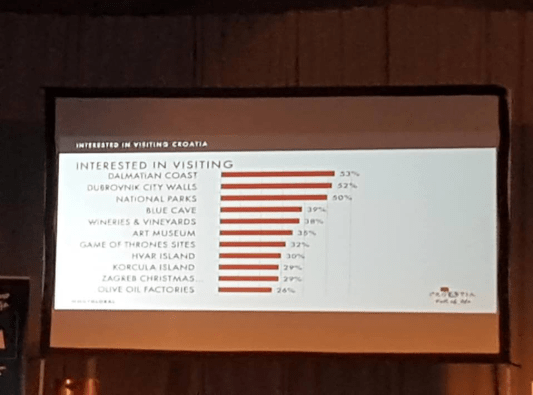Cultural Identity of Vukovar: New Book Presented in Vukovar
June 9, 2021 - The fascinating question of the Cultural Identity of Vukovar is researched in a new book edited by Dr. Mateo Žanić and Petar Elez. However, as the editors stressed in the introduction, further research is needed to encompass all social groups in Vukovar and their contribution to the heritage of Vukovar.
After being published back in April this year, the book „Cultural Identity of Vukovar – Contribution to Investigating Heritage and Successors“, was presented this Wednesday in Vukovar. As Ivo Pilar Social Research Institute writes on its website the book was published in cooperation with the Vukovar State Archive, so it was only suitable that the first book presentation was held in Vukovar at the videoconference hall of College Of Applied Sciences „Lavoslav Ružička“ (named after a famous Croatian chemist whose work is awarded a Nobel Prize). In addition, the event marked International Archive Day.
The book was edited by Dr. Mateo Žanić and Petar Elez, and the presentation, alongside editors, saw scientific experts Dr. Dražen Živić, Mirela Hutinec, and Dr. Domagoj Tomas talks about the book.
„Fast events triggered by globalization process and information revolution which paradoxically lead to today's societies being fiercely occupied with the meaning of past, and preserving its valuable traces. In that context, there is a spreading interest for heritage that holds an important component to understand the relationship between the past and present“, says the editorial introduction of the book.
The editors went on to explain how „the city proved to be futile to interpret the meaning of heritage and its contribution to cultural identity,“ and the editors wanted to present various aspects of Vukovar's cultural heritage.
Apart from editors Žanić (who wrote a chapter „Layers of memories and material heritage in modern-day Vukovar) and Elez (author of the chapter „State archive in Vukovar and development of archive service in Vukovar-Srijem County“), the book features eight more authors. Ivan Rogić (Whose Heritage? Who is the successor?), Dražen Živić (on Vukovar's feudalists), Vlasta Novinc („Danube, food, Corso“), Dragana Drašković (on the cultural life of Borovo Selo), and more by Dragan Damjanović, Toni Roca, Ivana Bendra and Ivan Hubalek.
With these broad presentations of culture and heritage in Vukovar, editors hope this book will encourage further research as they are aware this is certainly not the final word on these interesting questions and issues.
„As editors, we are aware that the book does not deal with topics that concern different social groups that left their trace in Vukovar end enrich the history of the city. We hope that future editions that will deal with this topic expand the reach of issues and help us to realize better what do we inherit from the past and why is that important“, concludes the introduction of the book.
So far, the book is available only in Croatian, and research that will, as editors say, deal with other social groups in Vukovar is yet to come. Keeping in mind the terrible aftermaths of the war in Vukovar in the 90s and inter-ethnic tensions, further findings on joint cultural contribution to Vukovar may indeed be the enlightenment needed for peaceful cohabitation and development of Vukovar as a perspective city in Croatia.
Speaking of heritage, learn more about UNESCO recognized heritage in Croatia on our TC page.
For more about science in Croatia, follow TCN's dedicated page.
Photo Exhibition For Croatian Army's 30th Anniversary
ZAGREB, 26 May, 2021 - On the occasion of the 30th anniversary of the establishment of the Croatian Army and Croatian Ground Army Day, the Dr Franjo Tuđman Military Academy organised a photo exhibition, with each photo representing one year of the army's existence.
The exhibition may be seen from today until 3 June and from noon to 8 pm every day at the Zagreb Student Centre's French Pavillion, the Defence Ministry said in a press release.
The exhibition will also be shown at the Zagreb National and University Library until 31 May from 8 am to 9 pm on weekdays and from 9 am to 2 pm on Saturday.
For more about politics in Croatia, follow TCN's dedicated page
"Croatia to The World" Exhibition Could Be Shown in Diplomatic Offices
ZAGREB, 14 May, 2021 - The fantastic exhibition "Croatia to the world" represents the best that Croatia has contributed to the world and it would be good if it were shown in diplomatic offices abroad to help to break down stereotypes, Foreign Minister Gordan Grlić Radman said on Friday.
He was accompanying diplomats accredited in Croatia who were visiting the exhibition at the Meštrović Pavilion. The exhibition honour 38 greats linked to Croatia whose work left a deep trace on humankind. Apostolic Nuncio Giorgio Lingua, doyen of the diplomatic corps, thanked the minister on their behalf.
"In order for the exhibition to be visible, it would be good if it were shown, for example, in Budapest, Berlin, Rome," Grlić Radman told the press.
That would help to break down the stereotypes about Croatia, which is often seen as a country of athletes, footballers, the most beautiful sea, nature and such, he said.
Today's visit was an opportunity for diplomats to get to know the many things they use every day without knowing who contributed to their creation, said Archbishop Lingua. "This is a good opportunity to see how much Croats have contributed to many fields in the world."
"The exhibition is an introduction to the unimaginable wealth of the Croatian cultural heritage," said Grlić Radman. It is dedicated to "extraordinary minds" linked to Croatia by birth, education or activity, he added.
The exhibition is dedicated to individuals whose work influenced global processes, changed the world or influenced global history, the minister said, such as inventor Nikola Tesla, presented as the man "who discovered the 20th century," or Nobel winners Lavoslav Ružička and Vladimir Prelog, or "the father of forensics" Ivan Vučetić.
Archbishop Lingua said he was pleased that today's visit was an opportunity "to see the world through Croatian eyes."
For more about diplomacy in Croatia, follow TCN's dedicated page.
Croatian Poet Criticises Petition Against Culture Ministry's Tender for Support
May the 14th, 2021 - As the new public tender by the Croatian Ministry of Culture and Media was met with the outrage by writers community, a Croatian poet ranting about writers ranting about the culture ministry is quite the turn of events. TCN reporter and slam poet Ivor Kruljac approves but also debates parts of the petition launched against the aforementioned ministry.
The ever-unfortunate literary scene in Croatia, which is sadly not represented as it should be neither in Croatia nor abroad, took heavy blows as a result of the coronavirus pandemic - much like the majority of other sectors. Popular literary events such as Interliber, and many more fairs ended up being cancelled, the blow to this specific branch of cultural industry that generally receives poor investments and poor profits thus became even more challenging.
To jump to the rescue, The Croatian Ministry of Culture and Media issued a public tender for both writers and translators. As Jutarnji list reported, the tender for the provision of financial aid to authors and translators for the best books and translations in 2019/2020 introduced a little novelty along with it.
''With the commissional value of the books, which in previous editions [of such tenders] was the only criterium of assigning financial support, this new tender also has a numerical valuing of literal works“, reported Jutarnji.
This numerical valuing is assessed by the number of awards, the level of participation in literal manifestations and festivals, and critical responses.
''Forty points goes to the winners of the awards: Janko Polić Kamov, Fric, Ksaver Šandor Gjalski, Edo Budiša, Vladimir Nazor, Kvirin, Judita etc. While rewards such as Post Scriptum, going to Fran Galović, Sfera, Tea Rimay Benčić etc, are worth only half of those points. Fifteen points can be received by participating in some festivals and manifestations, while the lower rank of such events is worth ten points. Ten points are also added for reviews in certain media while for others (this sometimes includes expert magazines), the critical review is worth only seven or four points,'' wrote Jutarnji List.
The literary community rebelled, and they started a petition called "The Right to Quality" against these propositions, demanding for the tender to be cancelled, which is supported at the time of writing this article with 233 signatures of Croatian writers and other concerned citizens.
''Public funding support for the best work has significant importance for the number of authors, which is why the authors themselves fought for the existence of this type of support with the initiative ''The Right to a Profession'', reads the text of the petition. The petition also welcomed the description of the criteria to improve transparency but determines that the quantification of literary value, which is a qualitative category in itself, ''disables the authors of a high aesthetic value to get the support their work truly deserves.''
Additionally, playwriters aren't even mentioned in this tender (despite grading rewards which are reserved for playwrites, poets, and essay writers, who are also in a bad position), and the winners of some of these awards will be known only after the ministry's tender closes.
The Culture Ministry could make many, many improvements, but, having the (mis)fortune of being present on the writing and more particularly, the poetry scene for the last six years (publishing and performing at various events, publishing short stories, and for better or worse, even being covered by the media for my work) I can't say, as a Croatian poet, that the arguments are really on the side of the writer's community either.
Here are several arguments regarding to petition (in bold), as well as counter-arguments (not in bold) from the most annoying Croatian poet in the country. I have no doubt my other colleagues will most likely hate me for it, but you, the reader, are free decide what seems to have more sense. Given the fact that Croatia is a democracy, the pluralism of opinions and civilised public debate is always welcome. Despite the fact that I will not sign the petition, you should sign it yourself if you feel it to be the right thing.

pixabay
Assigning the funds by the number of sold copies of books borrowed in libraries is problematic as it's not showing the work's actual quality. Readership is affected by various factors, which don't always come because of a book's quality, but from the previous visibility of the author and the budget the publisher has.
Well, how exactly do we determine the value of literary work? I'm no literature academic, and literary academics don't really communicate these ''legitimate criteria that makes a good book'' all that well. Additionally, these books which are labelled as being good, are so boring to the average reader, and then the reader often gets insulted by ''the intellectuals'' for reading such garbage. When you look at other arts, such as music, you can see that music academics favour some music over other types but then again, some music, known as pop, is made for common people and the artists don't focus on achieving some melodic masterpiece but rather to entertain their audience or send a brief message.
Why do writers who do the same get so ridiculed by academic circles?
Why are they ignored by Croatian publishers? Why do writers then insult the readers, making literature more repulsive to the audience, and then get shocked when there isn't a lot of reading done and consequently not much money to be had from the book business? This also makes the Croatian literary offer very poor, and often its style and topics end up being very similar as a result of this unexplained criteria. In return, there's very little Croatian crime fiction, SF, fantasy, love stories, and other genres, and the readers turn to foreign writers in search of such stories (Jo Nesbo, Stephanie Meyer, J.K Rowling. Lois McMaster Bujold and many, many more). Such writing makes them popular and also visible. That's the answer as to whose work gets most bought and borrowed in Croatia, give them the cash!
Poets are at a disadvantage from the very beginning. There are far fewer rewards for poetry than there are for prose, which means the poets can do nothing else but achieve fewer points. There's also less poetry writing in general, which means a lower amount of points coming from critical reviews. Child authors, essay writers, and comic book artists are in a worse position than poets as well.
The above gets right to the heart of the point from the perspective of a Croatian poet. But, why is it like that, exactly? Before the coronavirus pandemic took the world by storm, there were so many poetry events filled with poets performing and the audience coming to watch them perform. Be it slam poetry, open mics, or some other poetry events, be it in the libraries, bars, or clubs, it was apparent that Croatia doesn't lack poets, nor does it lack an audience for it. These events were in the majority and were always very open to newcomers.
Social media is also filled with people, either quoting their favourite poets or posting their own, personal poetry. So, why are there no more rewards and why is there not more extensive interest from the publishers (with some honorable exceptions) to invest in poetry and keep up with the trends? Culture journalists working for various media outlets should focus more on poetry as well, and coming from TCN's perspective, poetry articles really do attract an audience, as we saw on March the 21st (assuming that reporting on poetry, an important artistic and historical heritage of the linguistic form, isn't rewarding enough in itself).
Evaluating work by the number of reviews is problematic as books that are more visible, in principle, receive more reviews. The authors whose books are published by smaller editors, who have fewer resources to invest in their promotion, are in a less favourable position. In addition, evaluating the number of reviews where three negatives are worth more than two positives is also illogical in order to evaluate the quality of a piece of work.
On top of that still, the amount of points based on the media site on which the critic is published seems to be very random. The result is the unusual circumstance in which, if the same critic writes two reviews of two different books and publishes them on two different sites, depending on where the critic published the review, one writer will receive 10 points, and the other one four even if the first review was positive, and the other one - negative.
Again, the beauty is in the eye of the beholder, and there's no empirical way to determine which book is a good book and which isn't. If there were such a righteous empirical way of determining the quality of a book, we wouldn't have the difference between positive and negative reviews. Bad would always be bad, and good would always be good, and there wouldn't be any debates.
Take a look at the empirical field of physics and the definition of friction; ''Friction is a force between two surfaces that are sliding, or trying to slide, across each other“. This definition will always be the correct definition regardless of culture, personal preferences etc. Furthermore, positive reviews, even if done correctly by the rules of the still ''unclear criteria of literature scholars“, that wouldn't be set in stone.
When the poetry volume ''The Flowers of Evil“ by Charles Baudelaire was originally published back in 1857, the academics of the time condemned it as immoral and wrong, and of a poor quality, but today it is celebrated by the successors of that same academia, as one of the best poetry books ever. So, no writer should even care if the reviews are good or bad in terms of quality. That being said, reviews will raise a publication's visibility, attract readership, and inspire critics to write more reviews (combined with the PR done by the publisher). All of this shows the writer's ability to spark a reaction with their work. As such, whether a review is good or bad is irrelevant, but reviews do show the impact and public importance of the book, and therefore it seems to be quite the right direction to go in assessing books by the ministry.
That being said, the tender benefiting the publishing of one review in one media outlet over another is problematic if it doesn't better elaborate why some media outlets are favoured over others in the tender.
Furthermore, big publishers publish more books in larger quantities, and invest more in their promotion, and they already have a name that attracts the press. That is absolutely true. But, today, with the development of social media (which allows promotion without high expenses), and while journalists strive to discover new things, new names, new approaches - small publishers have never before been in a better position to push themselves and the writers they represent out into the public arena and develop and expand to the level of ''big players“. The only question is - do they have the will to do it?
It's not adequate that the esthetical value of a book is evaluated by attending events and manifestations. Festivals more often call upon already established authors who then have an unfair advantage. Additionally, every organiser mostly invites his own authors who again have an advantage over the others. The tender doesn't value international festivals, which causes a paradoxical situation in which the promotion in the organisation of the publisher is evaluated, but it's not evaluated when the promotion happens during an established international festival.
The term ''the presenting of the book“ is problematic for multiple reasons. First and foremost, the majority of these festivals don't present the book (and its a problem to prove that by participating in these festivals, the book was actually presented). Last, but not least – this is discriminatory towards authors of a weaker state of health, who are older (with the risk of the novel coronavirus still large) or busy with family and work obligations and are unable to travel.
Festival organisers do discriminate against writers, but whose fault is that exactly? Are these festivals organised by the Republic of Croatia, by the Ministry of Culture? If they are, then it's problematic, but if these festivals aren't organised by the ministry, then this whole petition is barking up the wrong tree. If the festival organisers aren't willing to be more fair and open to new names, then we, the writers, need to show solidarity with our colleagues and negotiate with festival organisers to invite our colleagues who are less presented to participate. If you're a writer/publisher seriously concerned with this issue, but you're among the lucky ones who get invited, use your position to help others out a little.
On the other hand, it's too bad international festivals aren't valued in the tender, and the ministry should work more in helping Croatian writers become more visible on the international scene. Regarding ''vulnerable writers, the old, the sick, and those too pre-occupied to attend'', they should be presented by their publishers, and an additional problem is that often the expenses of travelling to festivals aren't covered for the writer, and their participation costs money.
Awards such as the VBZ award, the Dragutin Tadijanović award assigned by (HAZU) etc aren't mentioned in the tender. Relevant international awards Croatian authors frequently are awarded, such as the Bridges of Struga (Macedonian award), the European Union Literature Award, the European Poet of Freedom, etc, are also ignored.
Every single award, be it Croatian, European or international, should be valued in the tender, but VBZ really shouldn't be. For those who don't know, the VBZ award is the annual award for the best-unpublished novel, and the winner sees their manuscript published, and there is a financial 100,000 kuna prize that goes with it too. With a huge monetary prize and the chance to have that piece of work published, why would VBZ be part of a tender whose goal is to financially help those writers who have run out of money?
The bigger problem is the question of how fair are these awards in the first place. Are they transparent? Are there no biases from the judges appointing these awards? Interestingly enough, there used to be an award called ''Kiklop'', which was given to the most purchased book in Croatia, but was cancelled in 2009 because the winning book by Nives Celzijus (about what's it like to be the wife of a Dinamo footballer) was considered by writing community to ''not be intellectual enough''. When in reality, for a book that can appeal so much to the Croatian readership, in a country that doesn't read much, such rewards should still be respected.
The final item of the tender that tries to consider the books that went unnoticed isn't going to accomplish too much. From the whole tender, it's visible that the emphasis is being placed on the work that received the most media attention and follows the old principle - The more attention something gets, even if it isn't good attention - the better.
Again, books should be visible to the public, and visibility should be awarded. The majority of publishers seem to see the distribution of a writer's work as their only job, and then they're surprised when despite distribution, the books just sit there not being snapped up by eager readers. Knock on doors, contact people, contact the press, everyone. Prepare a decent press release. Scream from the rooftops that you published a book from the top of your lungs and afford your writer the attention their work deserves. With the aforementioned development of social media, there's truly no excuse to be lagging in that respect today. Then, you'll get the media attention, and half of this tender would not be problematic at all. The problem is the policy of publisher's work and not the criteria by the ministry for this particular item.
Overall, the Ministry isn't without sin in this saga, but the Croatian writing community (particularly publishers, and event organisers) also needs to act differently to benefit the writers themselves, especially the new generations (and poets, stop forgetting the poets!).
Poets and writers deal with language, and you can learn more about the ins and outs of the Croatian language on our TC page.
For more about culture in Croatia, follow TCN's dedicated page.
Identity of Boka Kotorska Croatians - Scientific Conference by Ivo Pilar Social Research Institute
May 12, 2021 - Earlier in May, Boka Kotorska, in the town of Tivat in Montenegro, was the host of the scientific conference "Identity of Boka Kotorska Croatians" which will introduce changes in Croatian education.
Croatia has a big diaspora, no secrets there, but its worldwide spread makes you miss the region.
In Boka Kotorska, in Montenegro, Croatia's first neighbor on the southern border after Dubrovnik, not only is there a huge population of Croatians, but they also have a significant cultural impact on the area. So significant it even calls for social science to step in.
As Ivo Pilar Social Research Institute reported on its website, May 6 to 9 saw the conference “Identity of Boka Kotorska Croatians“. The three-day conference gathered crucial scientific institutes in Croatia to the town of Tivat in the Bay of Croatian Saints. Headed with Ivo Pilar Social Research Institute, Croatian Catholic University, Croatian Studies Faculty, Institute of Croatian Language and Linguistics as well as Institute for Historical Sciences in Zadar attended the conference while Croatian ministries of European, and Foreign Affairs, Science and Education, Culture, and Media, as well as Croatian Central State Office for Croatians Outside of the Republic of Croatia, founded the event.
„The scientific conference went well as well as signing conclusions with recommendations that that knowledge on Bokelj Croatians we learned on this conference enter the Croatian national curriculum in important subjects. These conclusions are the crown of our efforts to launch this conference in public, not just in an academical way, but to massively popularize to ensure long-term benefits for Bokelj Croatians as for every educated citizen of Croatia and Montenegro“, said Dr. Željko Holjevac, head of the Ivo Pilar Social Research Institute.
Conference conclusions suggest additions to the curriculum documents on key definitions of Croatian National Identity to make space for Croatians outside Croatia, including Boka Kotorska Croatians. Identity features and creativity of Bokelj Croatians in Croatian education, and the book „Boka Kotorska - the Bay of the Saints and Croatian Culture“, by Vanda Babić to be the mandatory literature for tourist guides in Montenegro.
Final meetings at the conference, as well as sailing with a „Katica“ ship through Boka Kotorska Bay, Saw the participation of Boris Bastijančić, the advisor and representative of the Montenegro president and representer of Croatian parliament and MP, Zdravka Bušić, and others.
„I'm glad to be at this scientific conference, and I want to thank everyone's effort for something like this to happen in Boka Kotorska. I would especially like to thank students that took part in this and gave their part as young people who love the truth of Boka, the place of saints. This is a message that we too need to do something to mark this time with love, hope, and faith“, said the Kotorska bishop, mons. Ivan Štironja.
Some Croatians live outside of Croatia, but maybe you would want to live in Croatia. Learn more about living in Croatia on our TC page.
For more about the Croatian Diaspora, follow TCN's dedicated page.
Miroslav Krleža Institute of Lexicography Publishes Book On All things Turopolje
May 7, 2021 - Last month, The Miroslav Krleža Institute of Lexicography had a presentation in Velika Gorica regarding the newly published book on all things Turopolje.
The ever-fascinating region of Turopolje, not so far from Zagreb, as the largest city of the region is Velika Gorica (connected by Zagreb with a regular public service bus) earlier this month good a book that gives an overview of every knowledge collected about Turopolje. Or in a noun: a lexicon.
As The Miroslav Krleža Institute of Lexicography informs on its website, the end of April saw the presentation of the latest work in the edition of the Institute in Velika Gorica.
In respect to the epidemiological measures, the presentation was held among a limited number of journalists and attendees. Nina Obuljen Koržinek, the minister of culture was present along with the mayor of Velika Gorica Krešimir Ačkar, and the head if Miroslav Krleža Insitute, Bruno Kragić. The county ruler of the noble county of Turopolje Mladen Klemenčić was present too and talked about the book. Katja Matković Mikulčić, the headmistress of Velika Gorica City Library and a co-editor of the lexicon, had an opening speech.
The accompanying culture program saw an actor and singer Adam Končić recite poems by Krleža (a famous Croatian writer, poet, publicist, and encyclopedist the Institute was named after) and pupils from Franje Lučić Art School that sing with the back-up of Krešimir Starčević that followed the notes of a famous conductor from Turopolje Franjo Lučić (the inspiration for the name of the art school).
As usual, the Institute was determined to gather as a wider circle of associates as possible, especially the authors. Some of the authors are individuals from heritage, educational, and cultural institutions, but researchers from specific scientific areas and noted publicists contributed to the book as well.
„The project started with the overwhelming support of the City of Velika Gorica, the central administration unit of Turopolje, and the cooperation contract was signed in 2018. With its concept and graphics, this lexicon continues the previous editions of the Lexicography Institute, which focuses on individual Croatian regions (Istria, Croatian Zagorje) or towns (Zagreb)“, the Institute's website quotes the foreword of the book.
When it comes to history, science, and art, museums are great institutions to learn more. You can learn more about museums in Croatia on our TC page.
For more about science in Croatia, follow TCN's dedicated page.
PHOTOS: Huge New Street Art by Zagreb's Lunar in Rijeka and Dobrinj
December 2, 2020 – Streets have been noticeably quieter over recent days, although not by one building in Rijeka and a roadside in Dobrinj, Krk island, where renowned street artist, Zagreb's Lunar, has left two huge new murals
The cafes are closed but, what's more, there's a chill in the air. It's not only the lockdown that has made the streets of Croatia more quiet than usual at this time of year. Over recent days, temperatures have dropped to around zero when the sun falls. And it falls early. The light can be gone by 5pm.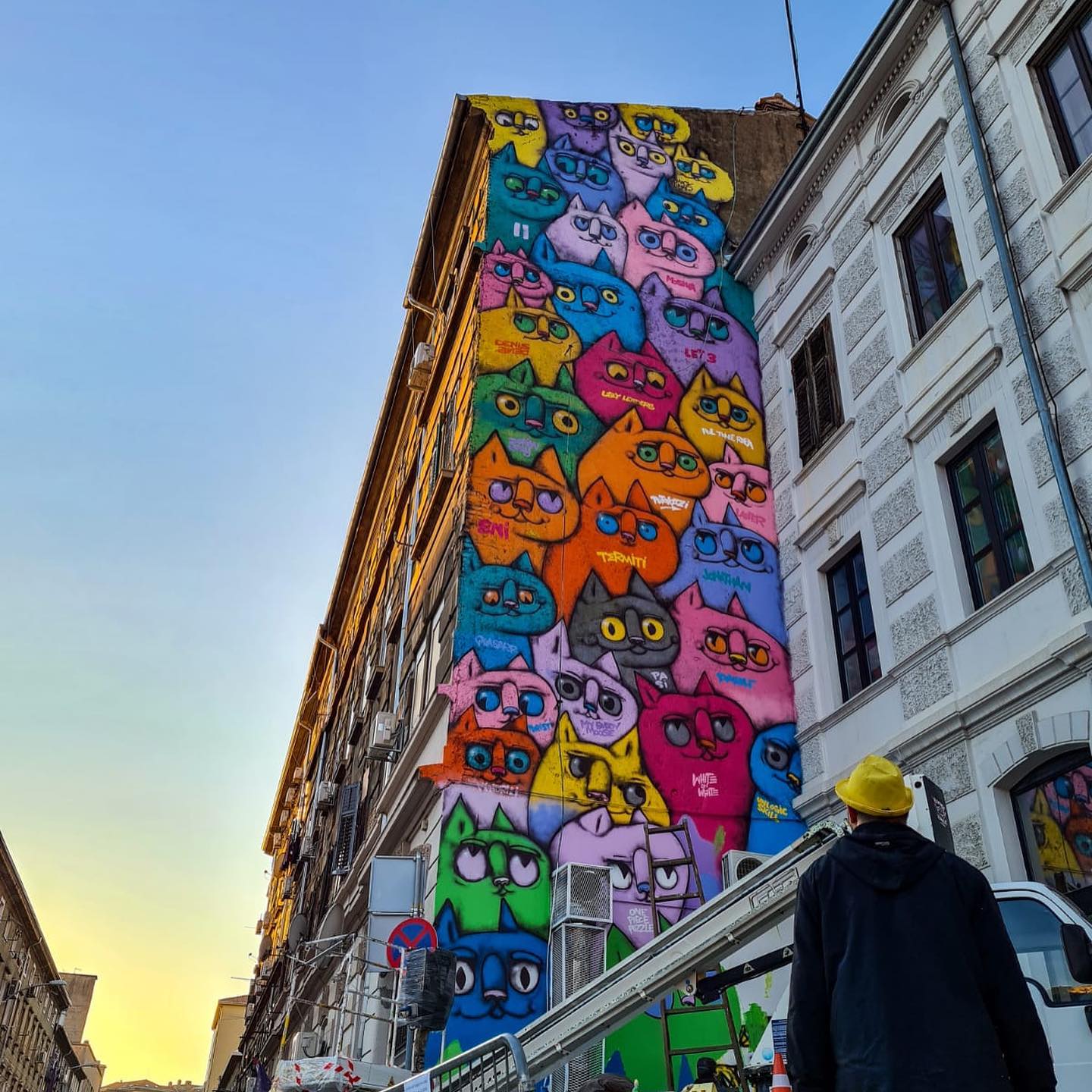 Rijeka
Rijeka
Exercise or a simple pleasant stroll around the Christmas lights have been all that's been drawing folks out onto the streets after dark, save for the food delivery guys whose bikes whizz past you faster than ever in the chill. Even during the day, the streets of Croatia are quieter than normal because of the lockdown.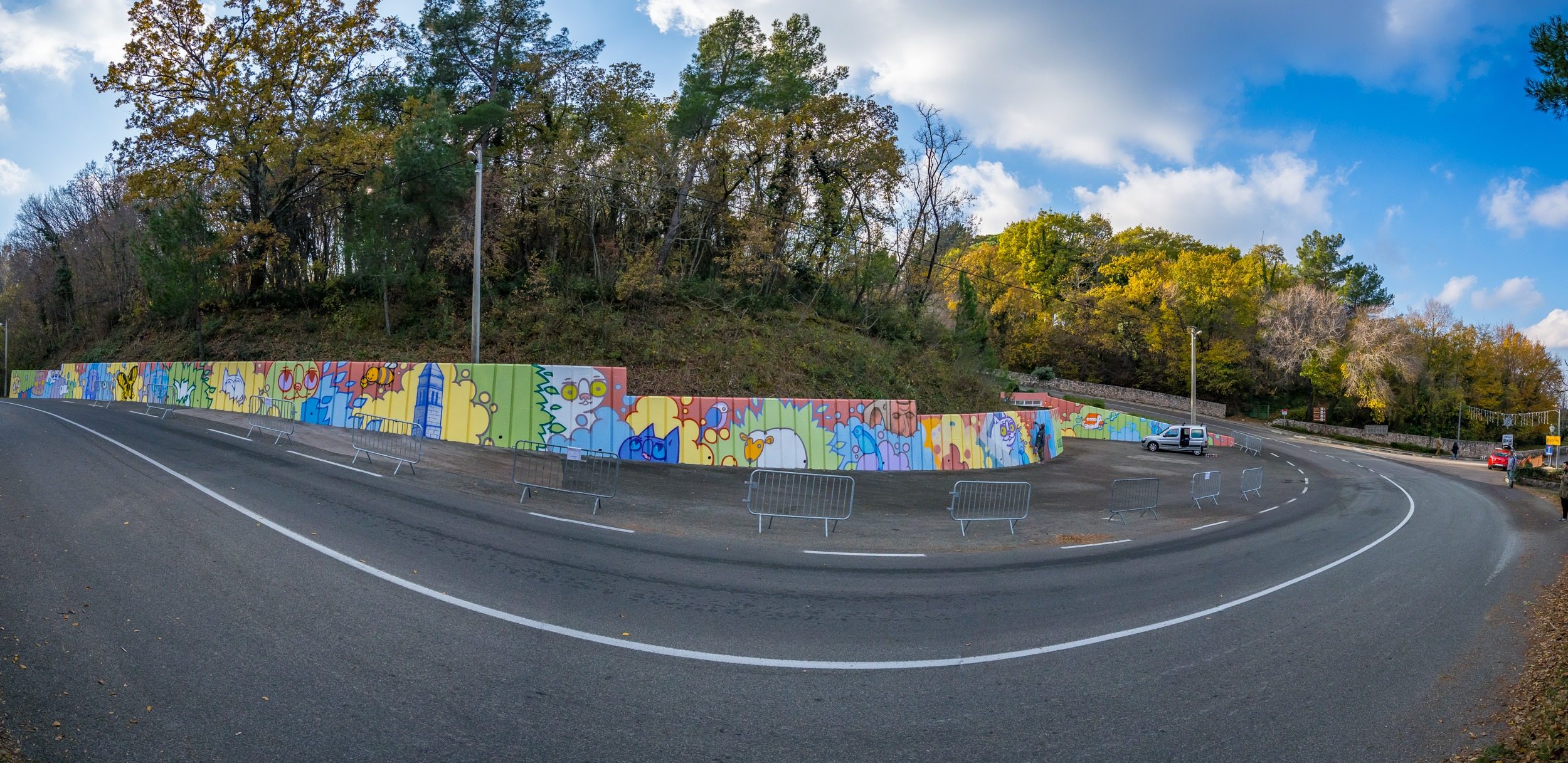
Dobrinj
But, these days haven't been anything other than normal for acclaimed artist Slaven Kosanovic aka Zagreb's Lunar. The cooler temperatures have only meant wearing more clothes and the quieter streets have not made his careful craftsmanship any quicker. His sometimes vast murals often require him to be above pedestrians passing below, up a ladder or even on a crane.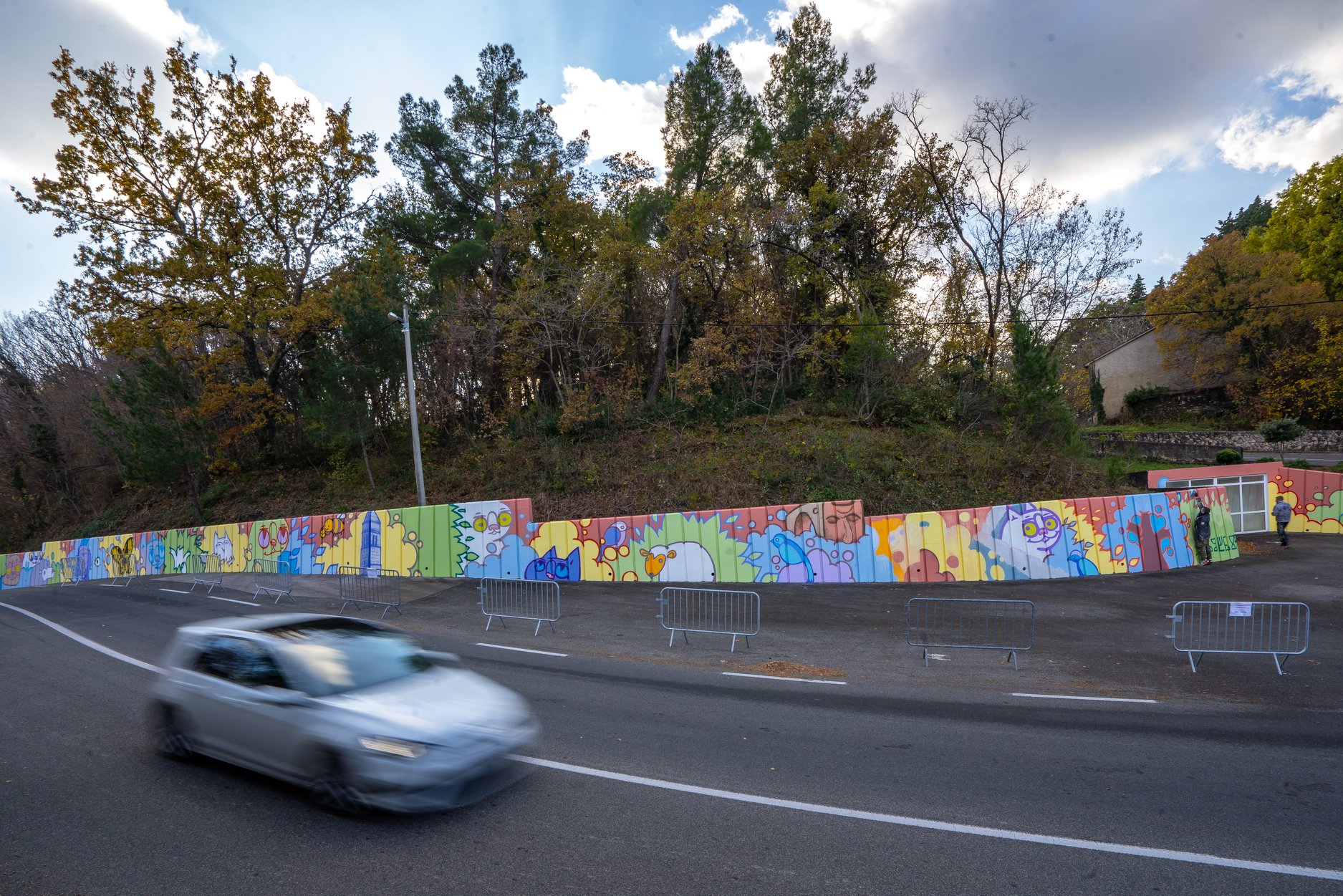 Dobrinj
Dobrinj
The two new paintings of Zagreb's Lunar definitely fall at the larger end of the works he has produced over the last 25+ years. One towers above street level on an entire building facade in Rijeka. So tall is the painting that trying to take it all in could strain your neck in the wrong wind. The other piece, in Dobrinj, Krk island, is just as epic, although this vast canvas lies horizontal, by the roadside.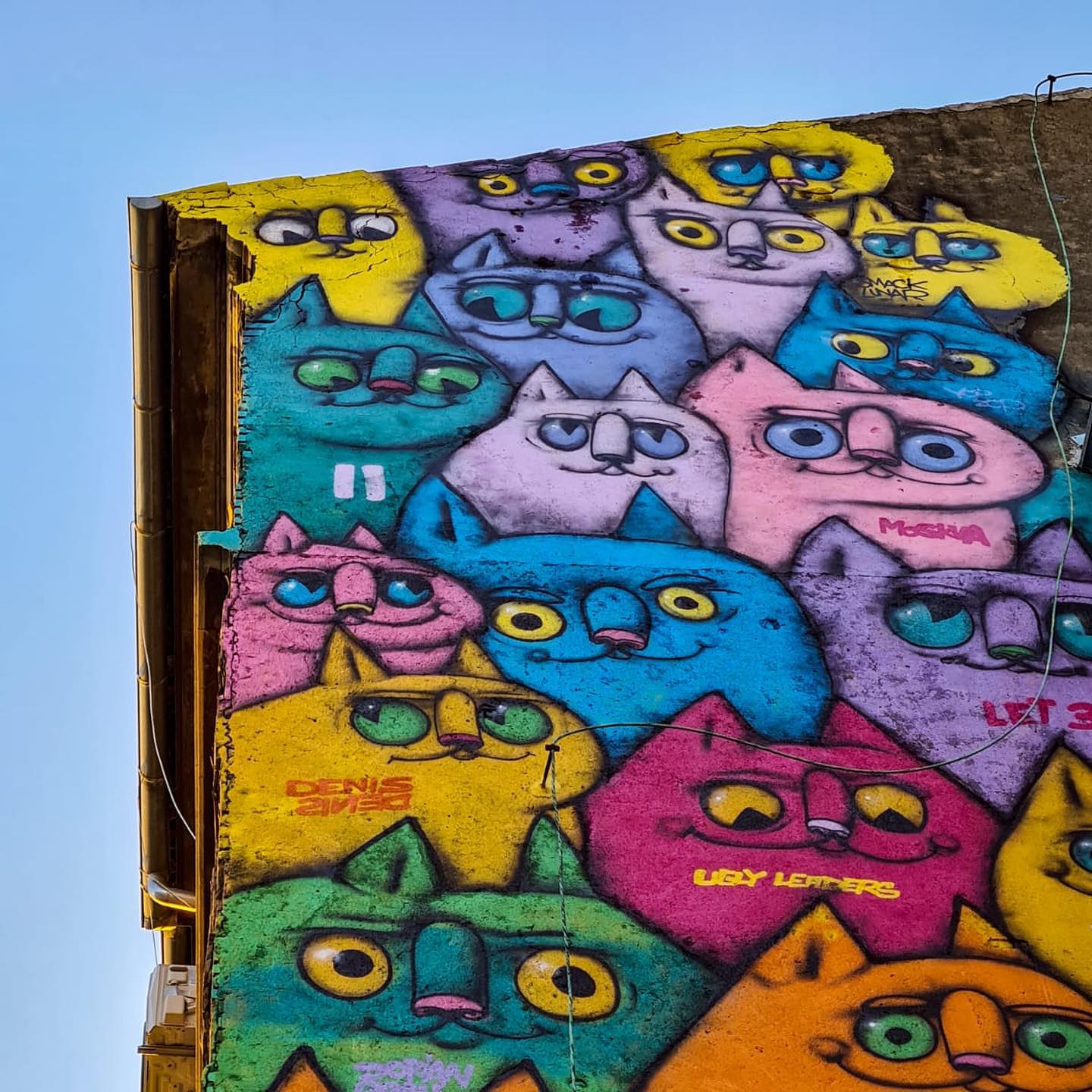 The Rijeka mural is dedicated to the city's music scene - you can spot some of the names of famous Rijeka bands in the painting
The Rijeka mural is dedicated to the city's music scene - you can spot some of the names of famous Rijeka bands in the painting
The Rijeka mural of Zagreb's Lunar, which he painted alongside his brother, with whom he often collaborates, is a four-story wall of cats dedicated to Rijeka's famous music scene. The mural took two days to complete. In the mural, you can spot the names of many Rijeka music groups like The Siids. Let 3, Denis & Denis and Jonathan. The mural is another part of the manifestations organised in celebration of Rijeka 2020 Capital of Culture.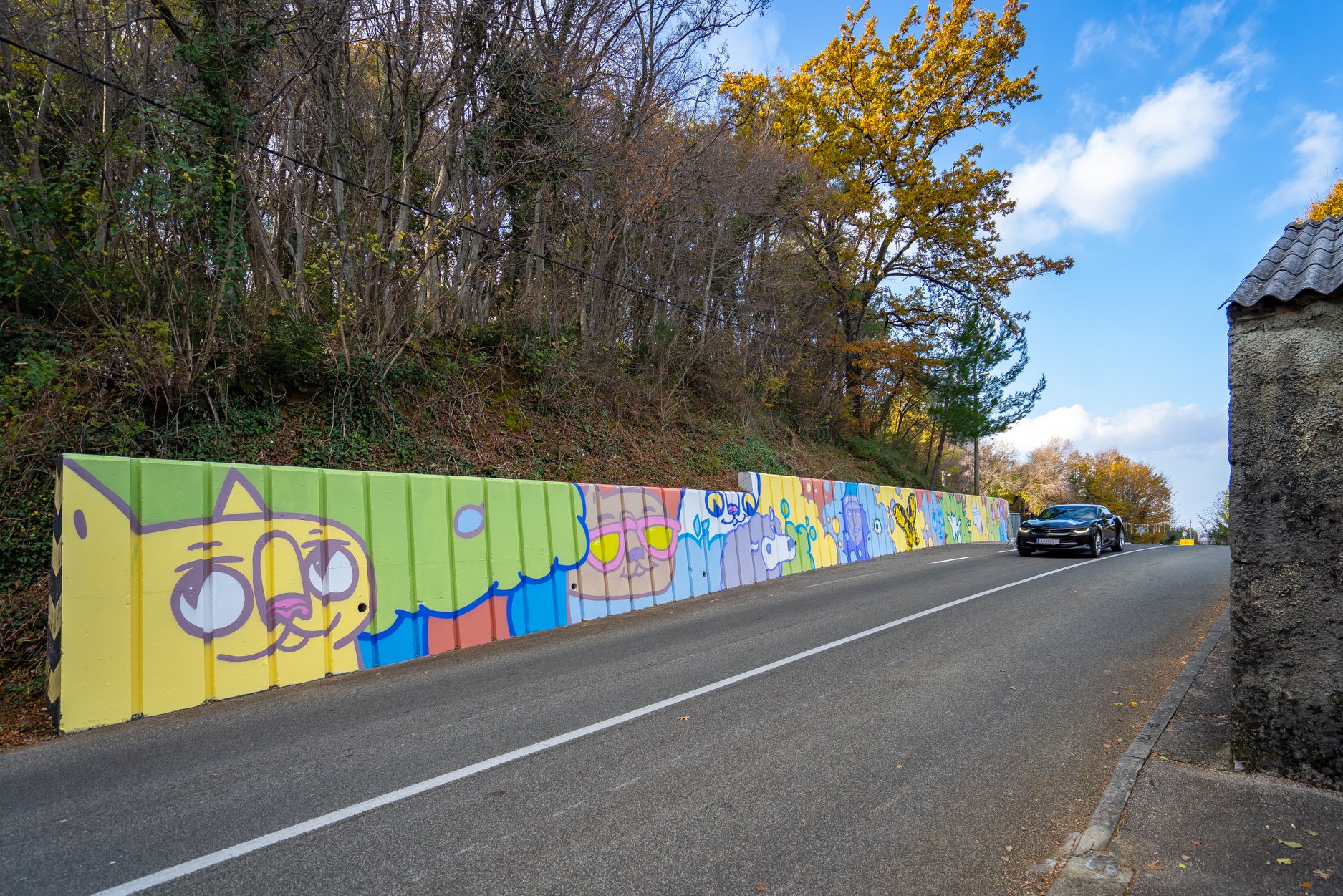 Dobrinj
Dobrinj
Krk island is a well-known tourist destination, but the pretty inland village of Dobrinj is far from the regular path of visitors. Anyone travelling past the enormous mural Zagreb's Lunar and his brother have left here will surely remember the name of Dobrinj. It may well entice some to come looking for it – it is by far the largest piece of public art on the island. It was facilitated by the community organisation Kulturni Dobrinj.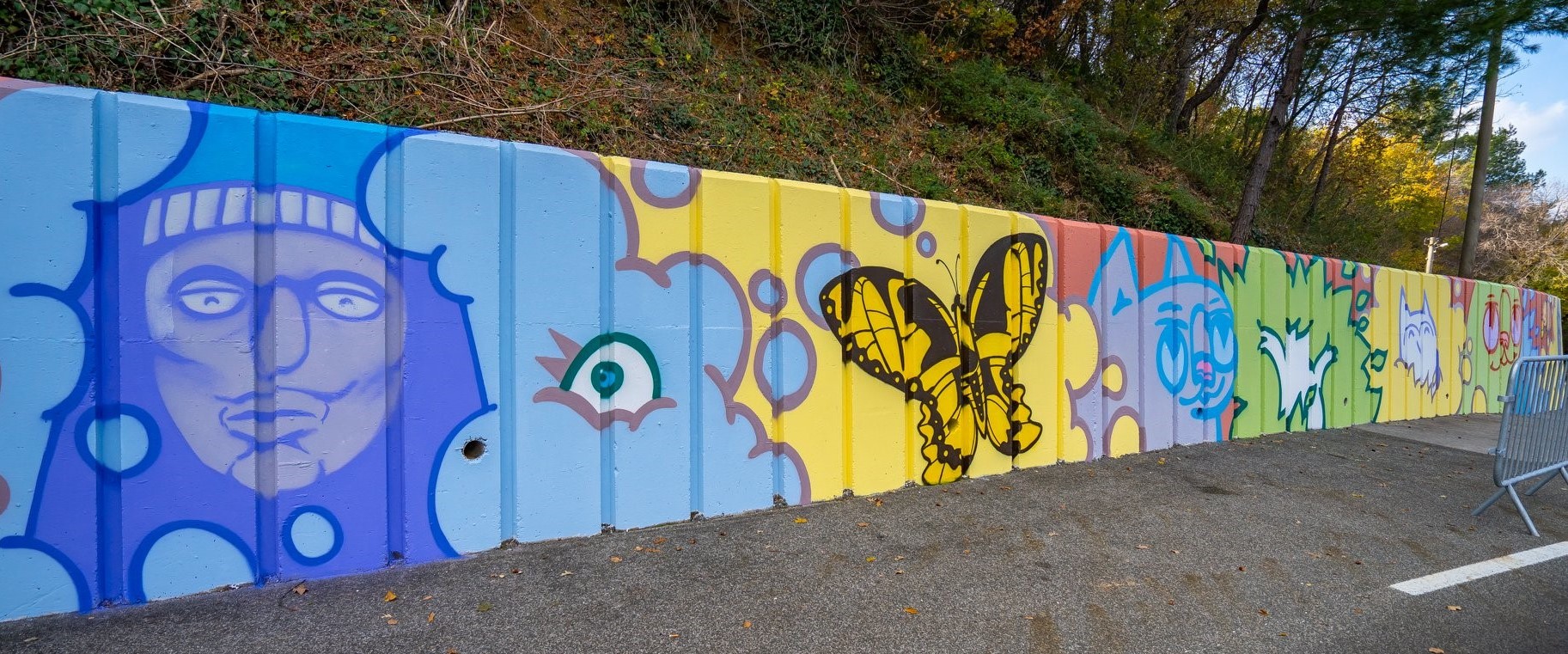 Dobrinj
Dobrinj
All photos © Antonija Diklic (Rijeka) Damir Jevtic (Dobrinj)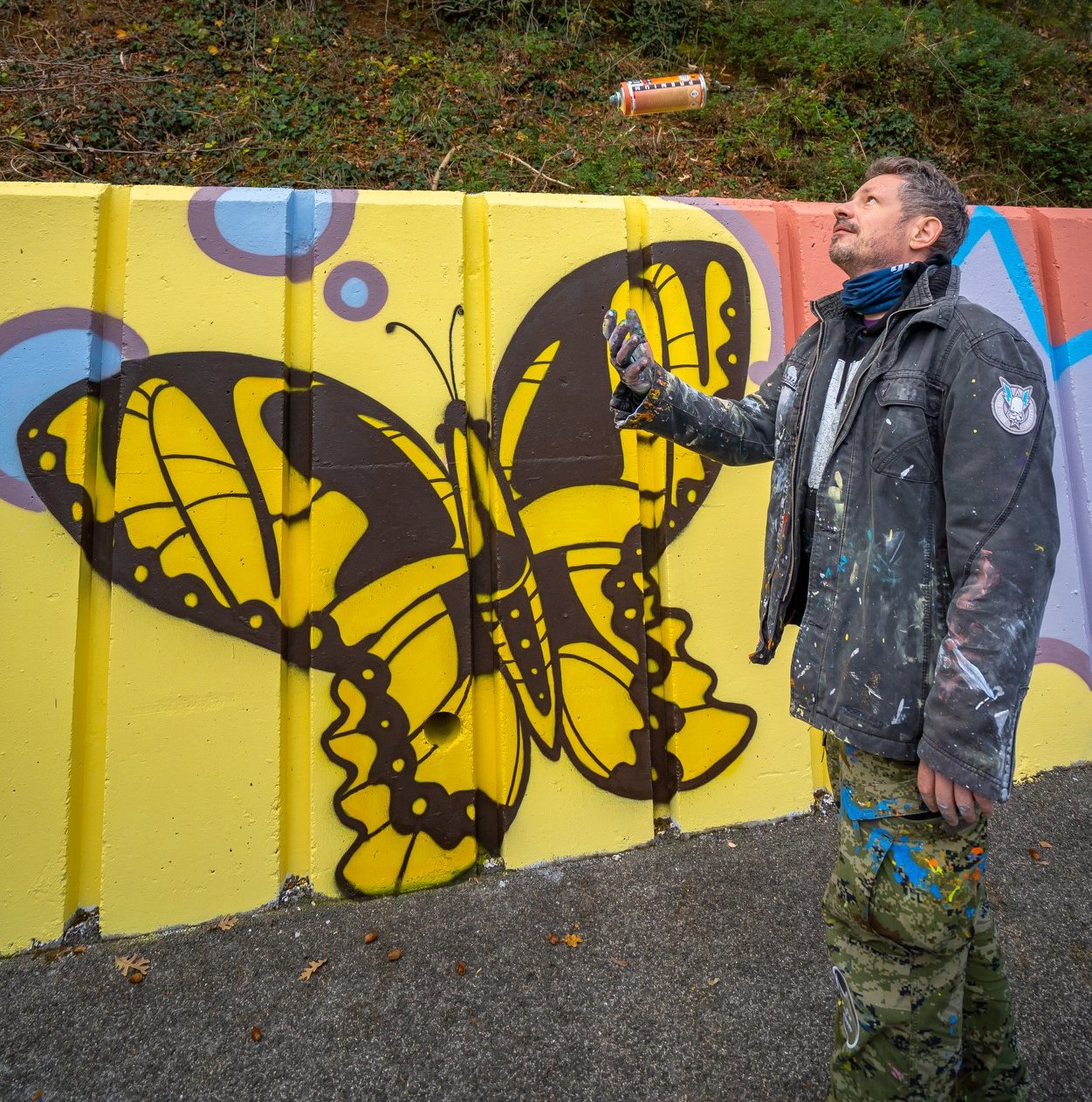 Dobrinj, with the artist, Slaven Kosanovic aka Zagreb's Lunar, on the right
Dobrinj, with the artist, Slaven Kosanovic aka Zagreb's Lunar, on the right
Croatian Sculptor Spends Hours Liberating his Piece "Vodan"
September 13, 2020 - The Croatian media reported about the sculpture near the Sava river earlier this year, in January. Now it's back in the news, as its author had to do more work on the favorite piece.
Robert Zdarilek (65) is a Croatian sculptor who spent years creating the sculpture right next to the Sava river, close to the iconic Hendrix Bridge in Zagreb (we've written about that bridge previously). During one of his regular walks along the Sava, he found one of the rocks from an old bridge protruding from the mud and decided to turn it into a sculpture. He used an ancient renaissance technique of sculpting and has created a head/face of a creature that appears to be living in the mud, sometimes submerged completely as the level of the river rises and falls throughout the year.
And now that the sculpture is living its riverside life, Croatian sculptor Zdarilek explains to 24sata how it's the first thing he does while walking his dogs, visiting Vodan and making sure everything is OK with his art. Nobody has damaged it in the past months, and sometimes other walkers spend time cleaning the face of the sculpture from Sava's mud. But, sometime during this last August things took a turn: in the morning, everything was all right, but in the evening, Vodan was covered with a lot of soil! Croatian Waters (Hrvatske vode) were performing some excavations, and just dumped the leftover soil right over Vodan!
Zdarilek explains that it took him two days to fully clean the sculpture, and he's asked those in charge at Hrvatske vode to be a bit more careful when performing such maintenance, as Vodan is an important piece of 'land art', well-known and liked by the people of Zagreb!
For the latest travel info, bookmark our main travel info article, which is updated daily.
Read the Croatian Travel Update in your language - now available in 24 languages!
Top 11 Croatia Travel Experiences American Tourists Seek: New Survey
What are the Croatia travel experiences Americans are looking for in Croatia? A new survey reveals all.
One of the highlights of this week's Days of Croatian Tourism on Hvar, which finished on October 25, 2018, was a presentation from Al Merschen of Myriad Marketing, on the results of a detailed survey of wealthy American tourists and their potential interest in visiting Croatia. Among the various results of the survey which were covered in Merschen's presentation (an overview of which you can read here), he revealed the top 11 things Americans want to experience when visiting Croatia. In descending order...

11. Croatia Travel Experience - Olive Oil Factories
They say a fish in Dalmatia swims three times in its life - firstly in the sea, then in olive oil during preparation, and finally in excellent Dalmatian wine. It is one way to enjoy three of the main attractions of life in Dalmatia. Croatian olive oil is EXCELLENT, among the best in the world, and it is little surprise that it is on the list of American desired experiences in Croatia. The next step to aid that process would be to build an online resource to facilitate tourism interest in olive oil.
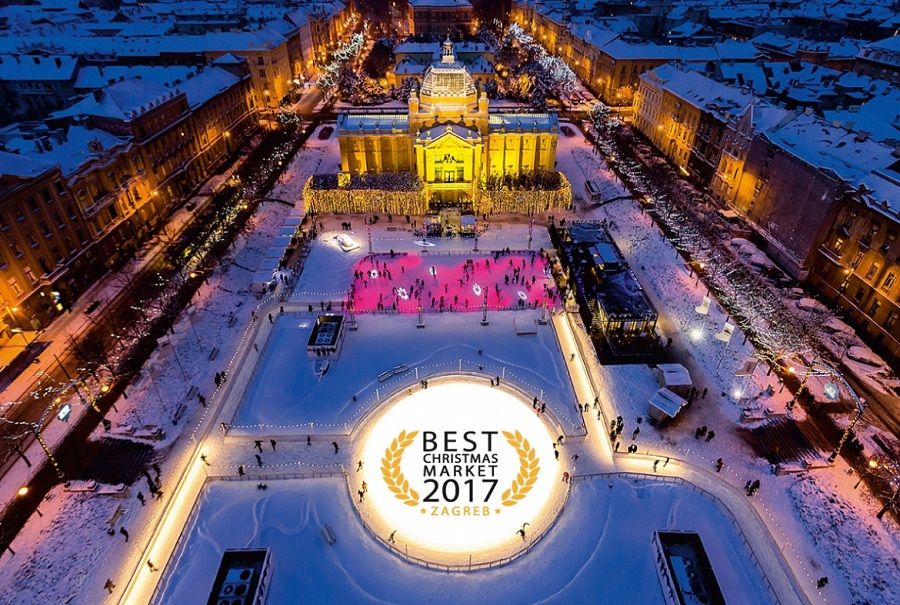
10. Croatia Travel Experience - Zagreb Christmas
A lesson for all in tourism worldwide - how to create a new product in a successful tourism country, far away from its main attractions - the coast and in summer - and within just a few years become the 10th most sought-after experience. Advent in Zagreb has been voted the best Christmas marketplace for three years in a row. A wonderful time to visit Croatia. Here is the TCN guide to Advent in Zagreb 2017.
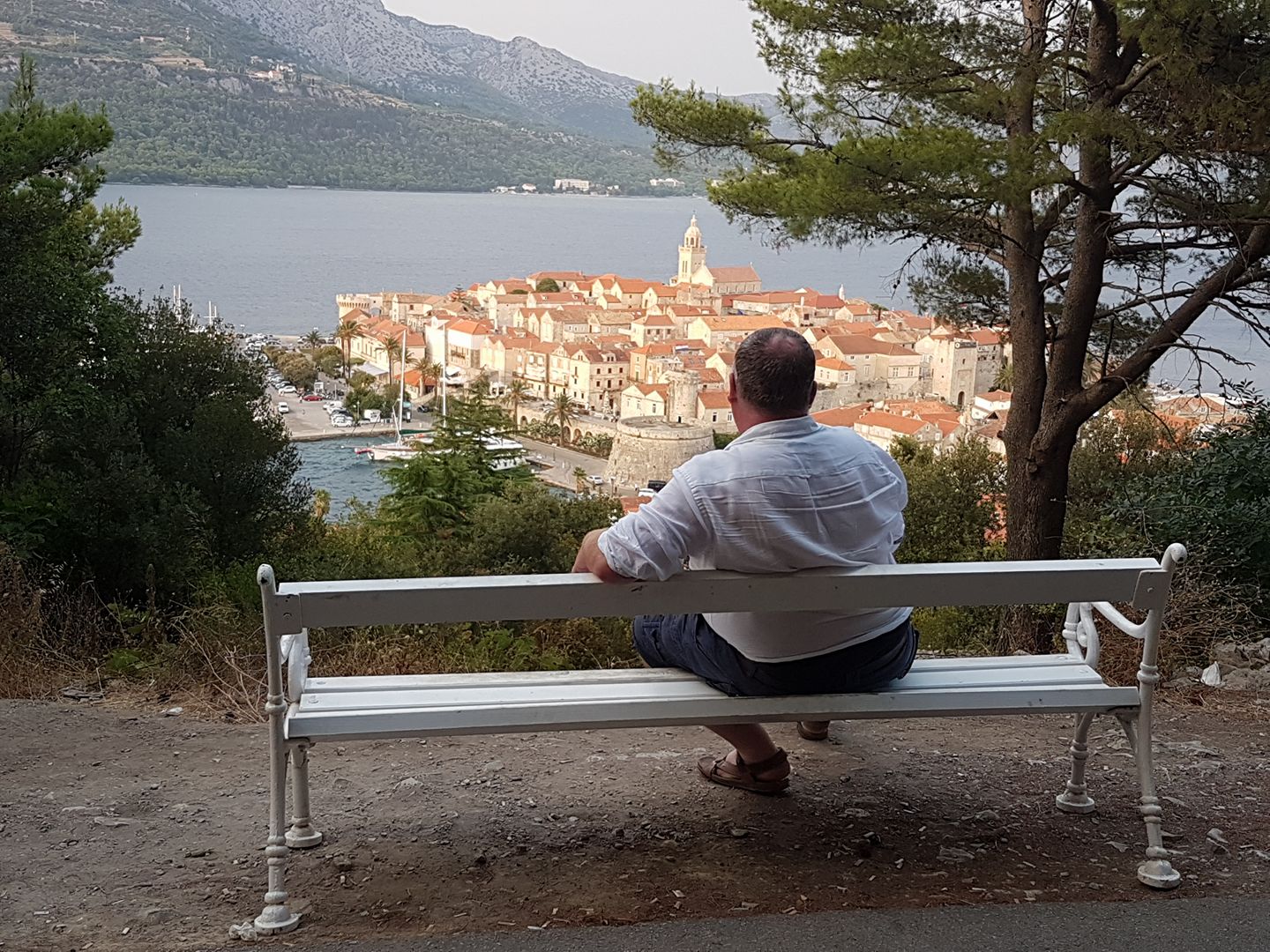
9. Croatia Travel Experience - Korcula Island
The birthplace of Marco Polo and also the 2018 Best Destination in Croatia, according to the annual Vecernji List Tourist Patrol. Thinking of visiting? Here are 25 things to know about Korcula.
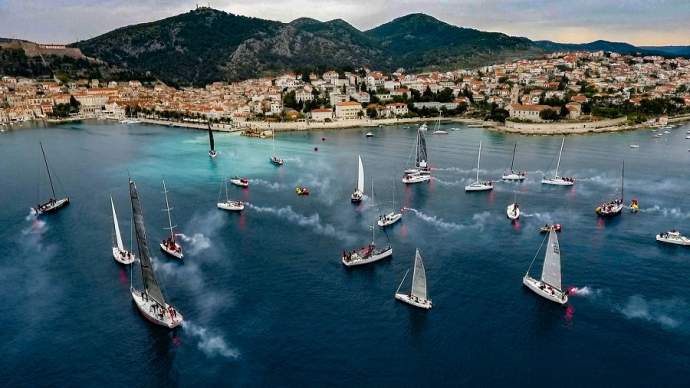
8. Croatia Travel Experience - Hvar Island
And if you are looking to combine as many of these Croatia travel experiences as possible, you are in luck - the island of Hvar is just a short catamaran journey from Korcula. Hvar, which is celebrating 150 years of organised tourism in Europe this year, is also home to the most island sun in Europe, the oldest public theatre in Europe, and the most UNESCO heritage of any island in the world. Here are 25 things to know about Hvar.
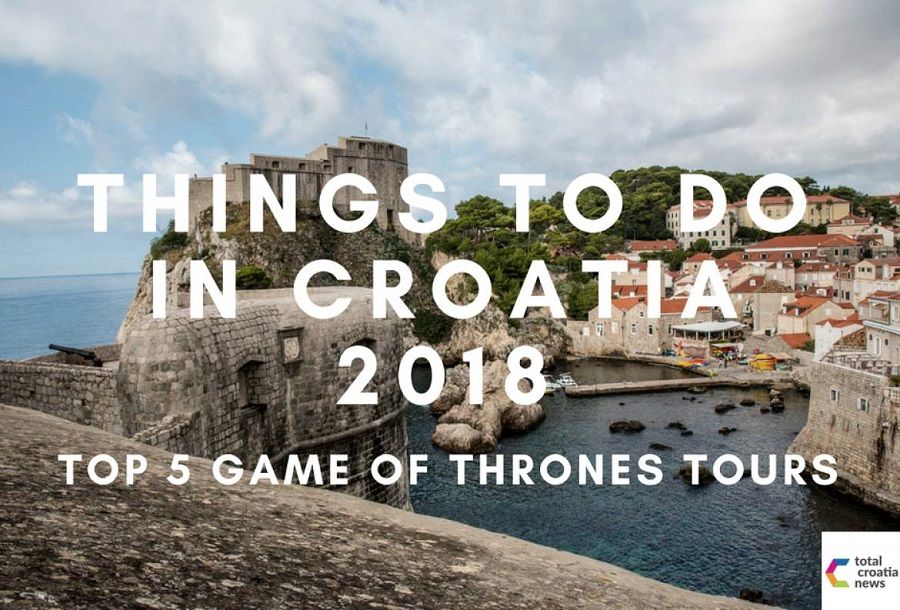
7. Croatia Travel Experience - Game of Thrones Sites
Croatia is popular for so many reasons these days, but there has been a real surge of interest in recent years from the hit HBO series Games of Thrones, which was filmed in various locations in Croatia. Learn more about the top 5 Game of Thrones tours in Croatia.
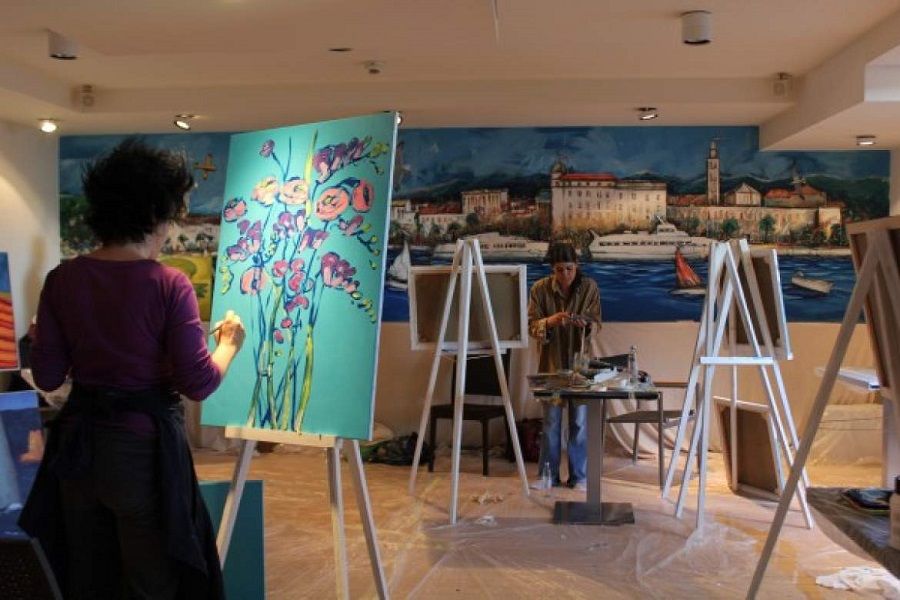
6. Croatia Travel Experience - Art Museums
Did you know that Zagreb has more museums per square kilometre than any city in the world? Allegedly, and many of which are art museums. Good news for our American guests, as Art Museums features high on the list of desired things to do.
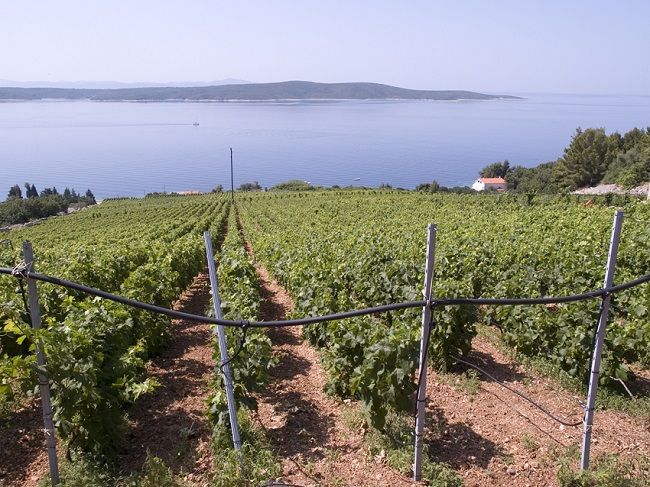
5. Croatia Travel Experience - Wineries and Vineyards
What to say? Croatian wine is fantastic! With more than 130 indigenous varieties, including the original Zinfandel, Croatian wine is so good TCN built an entire website to celebrate it. Learn all about Croatian wine on the TCN Total Croatia Wine website.
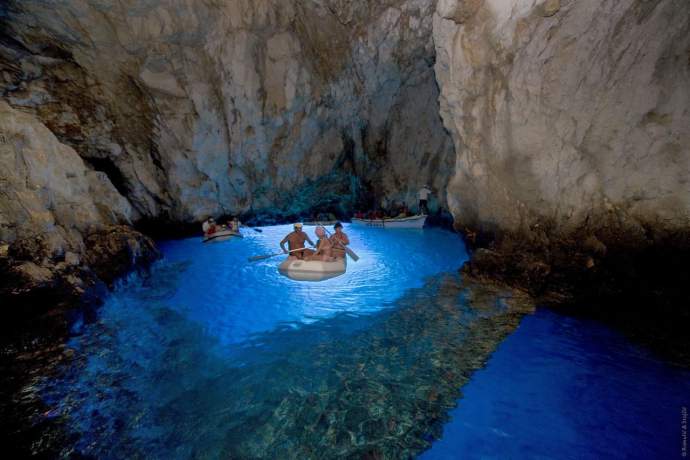
4. Croatia Travel Experience - The Blue Cave
The Blue Cave on Bisevo - one of the great natural tourist attractions in Croatia. Located close to the island of Vis, the Blue Cave tour has become insanely popular in recent years. Here are some things you need to know if you are planning a visit to the Blue Cave.
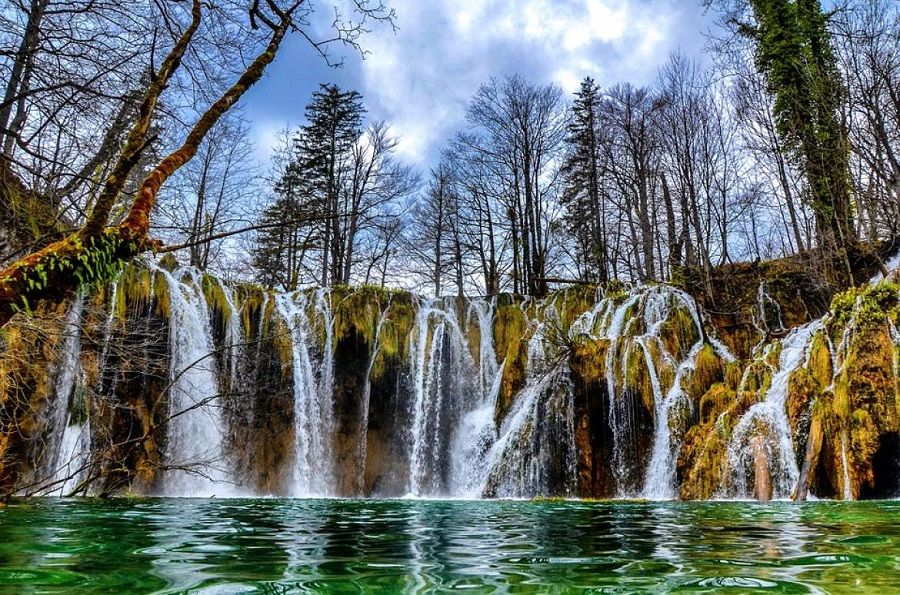
3. Croatia Travel Experience - National Parks
More than 10% of Croatia is covered by national parks and nature parks. Visit them, they are amazing. UNESCO World Heritage Site Plitvice Lakes, above, is magnificent in different ways all four seasons of the year.
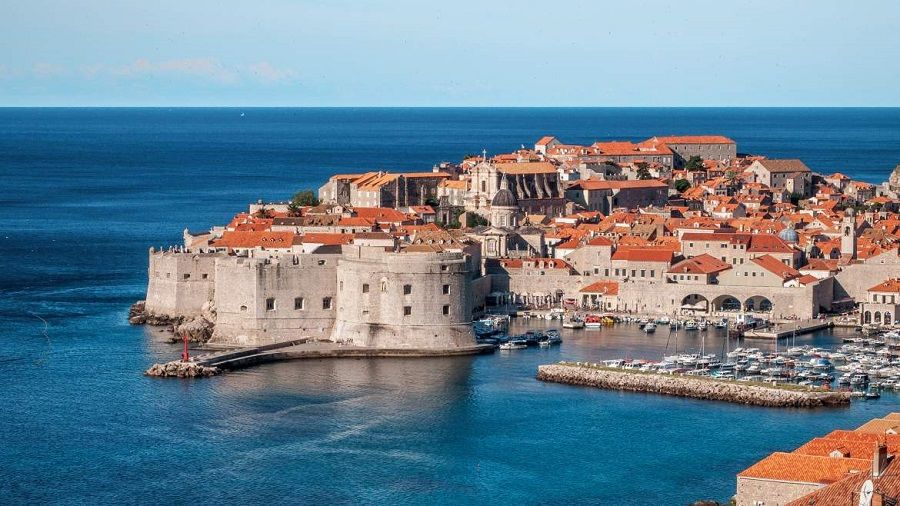
2. Croatia Travel Experience - The Old Walls of Dubrovnik
With more than a million people a year now walking the UNESCO World Heritage Site of the old walls of Dubrovnik, the walls were popular enough. Then came Game of Thrones and Kings Landing - no wonder the walls of Dubrovnik are almost at the top of the list. There is plenty more to do in Dubrovnik once you have finished a stroll around the walls - 25 things to know about Dubrovnik.
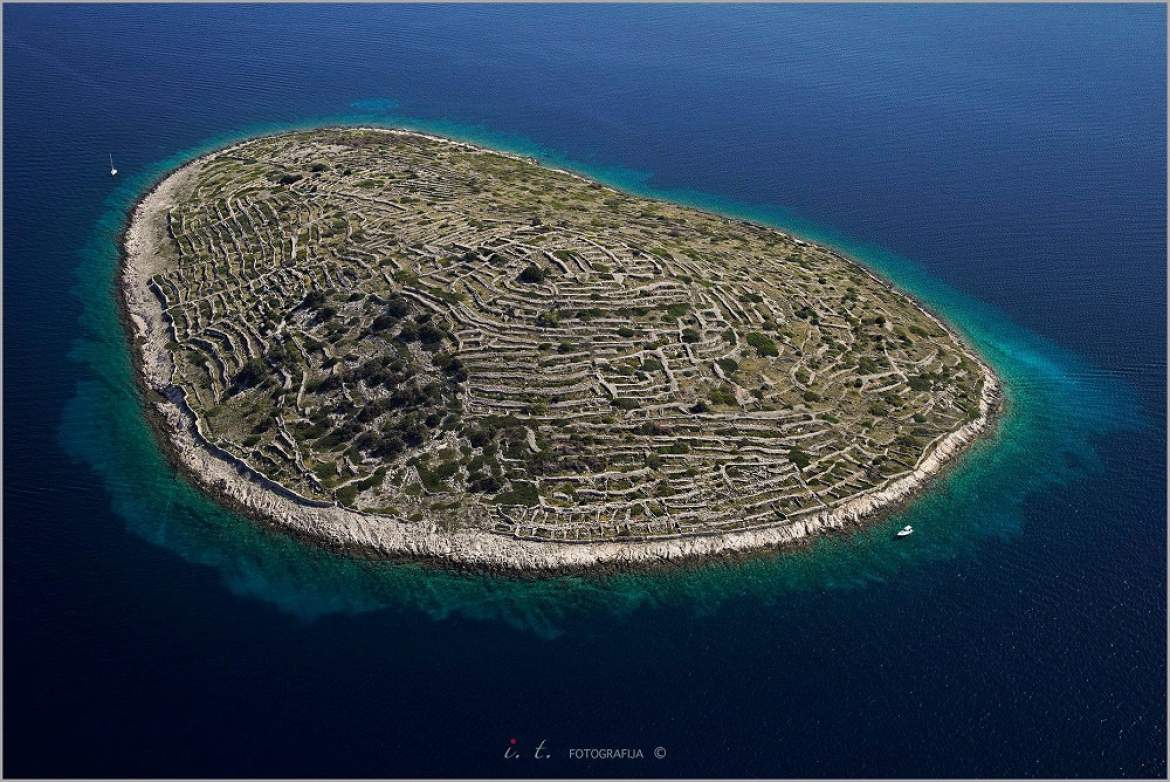
(Photo credit Igor Tomjenlovic)
1. Croatia Travel Experience - The Dalmatian Coast
And, with such a high quality of places to visit and things to experience, what could possibly be the most desirable experience for American tourists in Croatia? Why, heaven of course - the Dalmatian coast.
To learn more about Al Menschen's presentation on American tourism interest in Croatia, click here.
Exhibition of Contemporary Croatian Art Opens in Zagreb
Contemporary Croatian artists show their works


